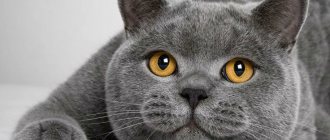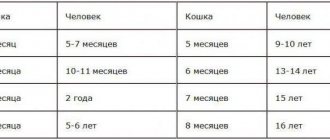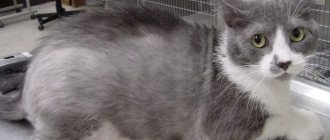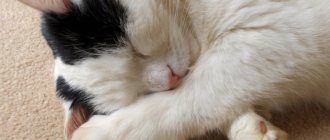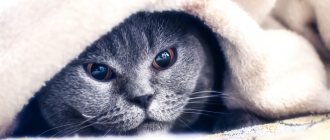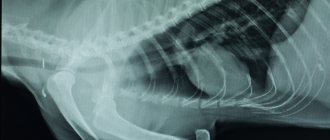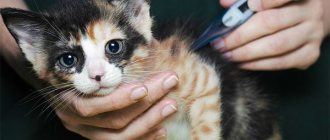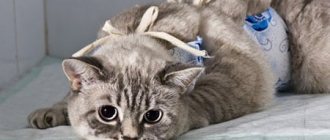In films and books, a person who shows little or no signs of life is first checked for breathing and a pulse. And this is quite justified, by the way. In veterinary medicine, the pulse of a cat (or other animal) is also of no small importance, since its readings can be used to judge the general health of the pet, as well as determine the presence of certain pathologies of the cardiovascular system.
Normal heart rate in a cat
Anyone who is used to monitoring their health knows that the pulse in adults ranges from 60 to 90 beats per minute, from 110-170 in infants and from 60 to 100 in adolescents. Unfortunately, not all owners know what a cat’s normal pulse is.
It is believed that
in an adult healthy animal the pulse value ranges from 100 to 140 beats per minute
.
At the same time, large cats have a lower heart rate than their small counterparts, and females have a slightly higher heart rate than males. Kittens' pulse is always high: from 150 to 190 beats per minute
. And a cat’s pulse at a very advanced age may be slightly lower than normal: 80-100 beats per minute.
Causes of increased breathing
In a healthy adult cat, the normal heart rate ranges from 100 to 130 beats per minute. Kittens have a more frequent pulse - 150–200 beats per minute. Males have a slower pulse than cats. Heat, stuffiness, fatigue, emotional disturbances, and stress can increase the animal’s heart rate.
Rapid breathing occurs in cats immediately after the birth of kittens. The animal's body returns to normal after stress, which is childbirth. Gradually, breathing stabilizes. Usually the cat does not need help.
Increased breathing in an animal can occur as a result of normal overheating. Since cats, unlike humans, do not have such an abundance of sweat glands, the animal tries to cool down by breathing quickly and briefly, sticking out its tongue. The animal can breathe frequently after active physical activity.
After surgery, including sterilization, the animal’s body recovers gradually after the medications administered. The depth and frequency of breathing may be affected. If breathing gradually levels out, the cat does not need help. If the situation worsens, the animal’s gums, nose and lips become bluish; this may indicate a complication affecting the cardiovascular or respiratory system. You should immediately seek help from a veterinarian.
Emotional experiences of the animal associated with severe fear or stress can lead to increased breathing. At the same time, the cat presses its ears and looks frightened. Can hide or attack. Tachypnea can be caused by severe pain.
Pathologies of the heart, lungs, endocrine disorders, blood diseases, diseases of internal organs associated with an increase in these organs in size, ascites, and increased abdominal pressure lead to increased breathing.
Diseases of the respiratory system can be obstructive. That is, increased breathing can be caused by a foreign object entering the trachea or bronchi, narrowing of the airways due to spasm or compression by a tumor.
Diseases can also be restrictive in nature, that is, they are associated with impaired expansion of the lungs.
Respiratory failure may be associated with helminths entering the myocardium, lungs and bronchi. Fluid accumulation in the lungs, swelling, and inflammatory processes can cause increased breathing. In this case, the general condition of the animal is disturbed, the cat becomes inactive, body temperature may rise, and appetite may decrease. There is no talk about the possibility of active games.
The inability of the blood to carry the required amount of oxygen due to anemia can cause the animal to hyperventilate. In this case, the cat experiences weakness, apathy, and loss of appetite. Vomiting may occur.
Increased breathing can occur due to injury, disruption of the pectoral and diaphragmatic muscles. The accumulation of blood or air (gases) in the pleural cavity leads to frequent shallow breathing and the appearance of foam mixed with blood on the animal’s lips. In this case, tachypnea disorders are not limited. The animal takes a forced position, severe shortness of breath develops, and if help is not provided, the cat may die.
Esophageal hernia and diaphragmatic hernia lead to breathing problems in a four-legged companion. Infectious diseases accompanied by fever can cause heart problems and increased breathing.
Heart pathologies (cardiomyopathies) often cause breathing problems. In this case, apart from rapid breathing and heart rhythm disturbances, the animal may not have any other symptoms. The cat may be eating and playing normally while the illness gets worse.
Thromboembolism of the artery supplying blood to the lungs, neoplasms in the structures of the brain, and a state of shock can cause rapid and shallow breathing of the animal.
In cats with a flattened muzzle, rapid breathing may occur due to deformation of the nasal bones. This condition cannot be corrected.
We suggest you read: Tartar in cats
The respiratory system of felines functions similarly to humans - air enters through the nostrils, passes into the upper part of the windpipe, trachea, and then into the lungs. The frequency of respiratory movements is normal if the animal in a relaxed state takes 20-50 breaths in 60 seconds.
In kittens, due to accelerated metabolic processes, the indicators vary from 30 to 50. With good health indicators, the cat’s pulse rate is 100-130 beats/min. The heart rate of babies can reach 150 beats per minute. However, when measuring indicators, veterinarians recommend paying attention to the following factors:
- The breathing of a cat in position, during lactation and estrus, becomes more frequent, which does not indicate abnormalities.
- Due to exposure to stress factors, such as moving, noise or play, cats begin to inhale air through their nose more intensely.
- In hot weather and high air humidity, the respiratory rate increases 1.5-2 times.
- You need to measure your pulse and breathing adjusted for the time of year. In winter, the breathing of animals slows down and is almost inaudible.
- Large cats breathe less frequently than small cats because the latter have a faster metabolism.
What is a cat's normal heart rate? In adult animals, heart rate can be affected by many factors, including:
- weight;
- age;
- physiological state;
- emotional condition;
- breed;
- presence of pathologies.
The normal pulse rate for a medium-sized cat that does not suffer from serious illnesses is from 110 to 130 or, according to various sources, 140 beats per minute.
The smaller and younger the animal, the faster its pulse will be. The normal heart rate for kittens is from 200 to 220 or even 240 (for the smallest) beats per minute. In newborn babies, it may be easier to measure the indicator by placing your fingers in the area of the heart, since the pulse at the hip may be difficult to palpate.
An experienced owner who knows what the pulse of a kitten and an adult cat is will always be able to determine the severity of his pet’s condition in critical situations and convey this important information to the veterinarian.
Acceptable living parameters for your pet
It was previously mentioned that it is very important that your first aid kit contains information about the normal physiological values of your patient. Why is this necessary? For several reasons:
- Deviation from these norms can be a warning sign for you that something bad is happening to your animal.
- The list will allow you to assess the severity of the violations. For example, a temperature of 39.3°C is only slightly elevated, since in normal condition it is 38.9°C. This will facilitate first aid and help answer the question of whether it is worth contacting a veterinarian.
This means that it is very important to learn how to determine the basic vital signs that are common for your four-legged companion.
Methods for measuring heart rate in cats
Sometimes, in order not to miss any disease in your pet, it is enough to simply measure its pulse in time. Let's look at how this is done. We humans, when we want to count our heart rate, we squeeze the wrist area. Where is a cat's pulse? The easiest way for an animal to feel the pulsation of the large femoral artery is to press on the inside of the thigh (in the groin, where the cat's leg connects to the body). But here we note that some wayward pets may simply not allow the owner to touch the groin area. Otherwise, the pulse of a cat, cat or kitten can be measured by pressing the palm of the hand on the sternum area on the left side
(where you can feel the heartbeat).
The cat's pulse rate is usually measured over 1 minute.
But what if the cat is indignant (breaks out, tries to bite, hisses, etc.)? Measurement time can be halved or quadrupled. For an aggressive pet, the measurement time can be reduced to 15 seconds, and then simply multiply the resulting value by 4 (the result of a 30-second measurement must be increased by 2). When figuring out what your cat's heart rate is, it's important to keep these things in mind:
- Pulse counting should be done when the animal is as calm as possible
. An excited cat's pulse is always significantly higher than normal; - During the measurement, the owner should under no circumstances shout at the cat
, hit or squeeze it forcefully. This will cause the pulse of the unnerved animal to jump up; - You should not measure the pulse of a sleeping pet
. During sleep, cats' heart rate is lower than when awake; - There is no need to put too much pressure on the cat's groin or chest
. With strong pressure, it is difficult to calculate the pulse rate correctly.
Basic information
Firstly, what is a pulse?
These are vibrations of the walls of blood vessels through which not only blood flows, but also “recoil” from heart contractions. Naturally, this is typical exclusively for arteries, since blood flows through the veins to the heart, which draws it in like a living pump. Normally, a cat's heart rate ranges from 120 to 140 beats per minute. But it may be less if we talk about cats of “giant” breeds, like Maine Coons. How can you feel it in your pet? No, you don’t need to touch his paw, since in cats the pulse is found by pressing your palm to the inner surface of the thigh.
https://www.youtube.com/watch?v=ytadvertiseru
The femoral artery vibrates noticeably there, and therefore it will not be difficult to do this. Remember that kittens' heart rates are significantly higher than those of adult animals, so don't be alarmed if you lose count while trying to count them. In very young babies, the heart rate can easily reach 190 beats per minute. This is significantly higher than the normal heart rate in cats. But there is no need to worry, as this is a completely physiological phenomenon.
By the way, do not try to check the cat’s pulse by firmly grasping the cat by the throat (and such unique people really do exist). No, you can really determine the heart rate this way, but the animal will not be happy about it. In addition, his heart will be pounding from fear so that the correct readings will still not be obtained.
But what should you do if the cat is particularly chubby, or twitches its paws violently so that it becomes impossible to count the number of heartbeats? In this case, you should focus on the cardiac impulse. But how to measure a cat's pulse this way? This is the name for the “vibration” of the chest wall that occurs during heart contraction.
Capillary refill time
Capillaries are microscopic blood vessels that reach almost every cell of the body. They are what gives the skin its pink color. By checking the capillary refill time, you can assess the condition of the cardiovascular system.
What is the best way to do this so that treating cats at home does not cause problems? Follow the steps below:
- Lift your pet's upper lip and use your finger to pull back the pink gum tissue. This will cause a short-term leakage of blood from the vessels and stop its flow in this place.
- Then release the pressure. Notice that a pale spot appears on the area of the gum that you pulled back.
- Now check how long it takes for its normal pink color to return. It is this period that will be considered the period during which the blood vessels are filled with blood again and will be called capillary.
Most often this interval is 1-2 seconds. In situations where the time increases to 2-4 seconds, you should consult a veterinarian. This may be due to dehydration or shock. And, when the capillary time is more than 4 seconds or less than 1 second, this is an emergency that requires an immediate visit to the clinic.
What does a healthy cat look like?
- Excellent appetite.
- The cat is not disheveled, has smooth fur, and takes diligent care of its coat.
- The nose is cold and moist (during sleep it can be dry and warm).
- The mucous membranes are pink and moderately moist.
- The cat does not hide from you and does not seek privacy.
- Temperature, pulse and respiratory rate appropriate for a healthy cat.
- There are no deposits, inflammations or crusts around the eyes.
- The skin should be free of scabs, ulcers and other lesions, as well as tumors that can be detected by palpation
- The animal should not be emaciated - in this case, the cat's ribs protrude - or too fat, since obesity also negatively affects the general condition of the animal.
- A healthy animal's teeth are white and its gums are pink, although some breeds have dark-colored gums.
- A healthy cat, especially a young one, is quite playful, alert and active, it has a very quick reaction, even in a sleeping animal, since cats have very sensitive hearing.
- A pitiful meow, a wet cold nose or, conversely, too dry and hot.
- Lack of appetite, refusal of water. As a result, there is usually severe weight loss and dehydration.
- Anxiety, nervousness.
- Heavy shedding.
- Constantly hides in secluded places, despite the fact that you try to lure him out and pull him out.
- The cat sleeps excessively, longer than usual and mostly lies on the litter
- The cat does not groom itself, does not lick its fur, does not sharpen its claws.
- Does not show interest in the world around him, the cat does not show a desire to go outside, apathy towards everything, does not play, and is in a depressed mood.
- There is obvious lameness.
- Vomiting and diarrhea are observed.
- Prolapse of the third eyelid in cats.
- Breathing is difficult (rapid, with wheezing, whistling).
- The gums bleed, spots and rashes are observed.
- The cat constantly bites, licks, scratches, scratches any specific part of the body.
- The cat coughs and sneezes.
- There is discharge from the nose and eyes.
- Heavy salivation.
- The belly is unnaturally swollen.
- While eating, difficulties arise: the cat chokes on saliva or spits out food, food falls out of the mouth, the cat eats very little.
- There is swelling of the limbs or swelling of parts of the body.
We invite you to read: Wet food and canned food for cats: rating of the best soft food
However, all symptoms do not appear at once and they are not always pronounced. Most often, one of the signs is most pronounced, while others accompany it and can be combined in various variations. The degree of the painful condition, the recovery of the cat or the deterioration of the condition can be judged by the disappearance of painful manifestations or the intensification of symptoms that are characteristic of a given disease or complex of diseases.
A healthy cat's temperature is considered normal, ranging from 38°C to 39°C. Sphynx cats can have a temperature of up to 41.5°C, and small kittens can have a normal temperature of up to 39.6°C.
If your cat's temperature rises above 40°C, this may be a sign of the onset of a pathological process. Typically, the temperature reaction is an indicator of the body’s reactivity, or natural resistance (the body’s resistance or resistance to the effects of viruses and bacteria, that is, immunity), but a sharp increase to 41°C degrees is an indicator of the need for urgent medical attention and assistance.
A rise in temperature can be triggered by excitement or fear, in which case the temperature does not last long. In addition, a cat’s temperature can rise after physical exertion, in hot weather, as well as in case of poisoning or as a result of electric shock. High temperature can also be caused by such a phenomenon as hyperfunction of the thyroid gland.
Research by American scientists in 2001 (I. Calcagno) showed that the most common causes of a sharp rise in temperature (or fever) in 40% of cases are infectious diseases, systemic diseases and oncology occupy 20% in equal shares, other diseases and idiopathic fever accounts for 10%.
Your cat's normal temperature may differ from the average (just like in humans, 36.6°C is an average, not an individual). Therefore, it is recommended to measure the temperature of a healthy cat and record it. This measurement must be taken when the cat is in a good mood and at rest.
The measurement procedure is quite simple, but for cats that do not trust you or resist the procedure, you should first prepare a large towel or blanket for restraint. Your cat's first aid kit should have its own thermometer, since temperature is measured rectally. To measure with a regular mercury thermometer, prepare it for measurement according to the instructions (shaking it off several times), smear it with Vaseline or other fat and carefully, turning it slightly, insert it into the rectum 1.5-2 cm.
For the same purpose, you can use more modern electronic thermometers; the measurement is carried out using the same method according to the instructions for the thermometer.
The pulse reflects the frequency and rhythm of the heartbeat, as well as the force of the heart muscle impulses. At rest, the heart rate of a healthy cat ranges from 110 to 150 beats per minute. Large cats and animals that lead a quieter lifestyle have a slower heartbeat. The pulse increases when the temperature rises, during inflammatory processes, physical activity, overexcitation, fear and hot weather.
In kittens and cats of small breeds, the pulse rate can reach 200 beats per minute; in cats, the pulse is lower than in cats. Count and record your cat's resting heart rate - this will help you determine in the future whether its rate has changed in a given situation. It is enough to calculate the number of shocks in 15 seconds, and then multiply the resulting value by 4.
It is convenient to determine the cat's breathing rate by movements of the chest, abdominal wall or wings of the nose. Normally, it ranges from 20 to 30 respiratory movements per minute. Kittens and young animals, which have a more active metabolism than adults, breathe more quickly than adult cats, and females breathe more quickly than males.
Changes in your cat's breathing rate can be caused by fear, pain, shock, or respiratory illness. It should also be taken into account that breathing becomes more frequent in hot weather, during physical activity, and when the cat is excited. The breathing of a healthy animal after exercise is restored within a few minutes.
In a sick cat, breathing becomes frequent or, conversely, rare and cautious (if painful), wheezing, wheezing, coughing, and shortness of breath appear. Shortness of breath in a cat can be caused by increased physical activity, asthma, inflammation or emphysema, which, in turn, is a consequence of poisoning.
The cat's pulse is higher than normal
We found out above what a cat's pulse should be normally. But what if the pulse rate of an adult animal exceeds the specified limits, exceeding 150 beats per minute? Then we can safely talk about tachycardia
– pathological increase in heart rate. This is a dangerous disease that, if untreated, can lead to serious problems: ischemia, heart failure, thromboembolism, myocardial hypoxia, pulmonary edema and general deterioration of the body. If you do not seek medical help on time, unfortunately, death cannot be ruled out.
In addition to a rapid pulse, tachycardia in a cat can be recognized by the following symptoms:
- Severe, persistent weakness (the cat looks tired even if it moves very little);
- Arrhythmia (pulse is irregular, the heart beats either too quickly or too slowly);
- Frequent breathing, shortness of breath even after a quiet walk;
- Paleness of the mucous membranes;
- Possible cough;
- Loss of consciousness.
The most common causes leading to the development of tachycardia in cats include:
- Heart disease (cardiomyopathy, myocarditis, etc.);
- Diseases of the respiratory system, non-infectious and infectious (pulmonary failure, lung cancer, tuberculosis, pneumonia, etc.);
- Endocrine disorders (diabetes mellitus, hyperthyroidism);
- Inflammatory processes (pancreatitis, gastritis, colitis, endometritis, etc.);
- Blood parasitic infections.
If your cat's pulse is constantly elevated, you should visit your veterinarian (ideally, a veterinary cardiologist) as soon as possible. The specialist will take the animal’s blood and urine for analysis, conduct an electrocardiogram and echocardiogram, and, if necessary, an ultrasound and x-ray of the sternum and abdominal cavity. Treatment will be prescribed after an accurate diagnosis has been made. But we strongly recommend that you refrain from self-medication so that something irreparable does not happen.
How to measure your heart rate correctly
First of all, you need to know how to measure a cat’s pulse without having any special skills. In order to feel the pulse, we need to feel a large artery - it is in these vessels that the pressure is highest, and the movement of blood is well determined by the fingers.
https://www.youtube.com/watch?v=ytpolicyandsafetyru
You shouldn't do research after chasing a cat for two hours and trying to fish it out from under the sofa. It’s better to wait until the animal is lying quietly or sleeping, then the indicators will be most accurate, and you won’t have to think about what the cat’s pulse should be after physical activity.
The femoral artery is usually used to measure the pulse: it is quite close to the skin and is easy to find without special knowledge of animal anatomy. We place our palm on the cat’s inner thigh, press it against the body and feel a slight rhythmic pulsation - now we know where the pulse is measured most often in cats.
Of course, if it is impossible to determine it on the hip, you can carefully grab the animal’s throat or place your palm in the area of the first 5 ribs on the left, but these methods are less convenient and the animal may not like it.
After we have found the pulse, we note the time (1 minute, 30 or even 15 seconds) and count the number of beats. If you timed 30 seconds, multiply the value by 2, if 15, by 4. It’s better, of course, to time a minute at once, but this can be difficult to do for many reasons (due to the high heart rate of cats, it’s easy to lose count; a cat may not be able to withstand a minute in this position, etc.).
In general, we have already partially touched on this issue above, but it still wouldn’t hurt to reveal it in more detail. Most often, an increased pulse is detected, and this may be due to:
- Almost any infectious disease.
- Emotional excitement, sexual desire. The latter is especially typical for March.
- Myocarditis in the initial stages. When the disease develops, the pulse slows down and its filling decreases.
- With many poisonings, the pulse also increases sharply at first, it is tense and very full, but subsequently all these indicators decrease just as much.
- A catastrophically strong decrease in filling is typical for cases of collapse.
Veterinarians emphasize that a normal pulse in cats and breathing rate are indicators of good health. A significant excess of the norm, not caused by the influence of stress factors, serves as a signal for hospitalization of the animal. If your cat is choking or showing signs of a heart attack, your pet needs help at home.
Symptoms
Oddly enough, an increase in heart rate of more than 140 per minute that occurs suddenly is usually well tolerated by patients. Such an attack can even last for several days, and the patient does not notice it or only feels weakness that is incomprehensible to him.
The more the heart muscle is affected and the more severe the heart disease, the more signs appear during an attack of tachycardia:
- chest pain;
- shortness of breath, lack of air, especially when lying down;
- sweating, severe weakness;
- dizziness, clouding of consciousness;
- fainting, loss of consciousness.
In the most severe cases, there is a risk of developing a stroke.
The cat's pulse is below normal
Tachycardia or rapid pulse is a dangerous disease. What if the cat’s pulse is below normal? This is also bad: bradycardia
(low pulse) leads to severe weakness, the formation of blood clots, with this disease the internal organs are poorly supplied with blood and quickly fail. In addition, this is also dangerous, since with bradycardia, animals often lose consciousness.
Sometimes bradycardia is accompanied only by weakness, but in advanced cases the following symptoms may be present:
- Impaired coordination of movements (the cat has a “drunk” gait);
- Fainting;
- Arrhythmia;
- Periodic seizures;
- Jumps in blood pressure (normally, a cat’s blood pressure ranges from 105/65 to 135/95 mm Hg);
- Labored breathing.
Bradycardia in a cat is not an independent disease. This is a symptom of other serious illnesses:
- Poisoning (insect and snake poisons, lead, pesticides, etc.);
- Heart problems (myocarditis, cardiomyopathy, aortic stenosis, etc.);
- Sepsis in infectious diseases or as a complication after surgery;
- Hypothermia;
- High intracranial pressure due to traumatic brain injury and brain diseases (meningoencephalitis, meningitis, epilepsy, etc.);
- Heavy bleeding;
- Hypothyroidism;
- Anemia;
- Constant stress;
- Overdose of cardiac drugs.
It is possible to rid a cat of bradycardia if the cause of the low pulse is determined. To make a correct diagnosis, the doctor will prescribe urine and blood tests, as well as important studies: ultrasound and x-ray of the heart, as well as an electrocardiogram.
When do you need to see a doctor?
To accurately determine the causes of disorders, the veterinarian prescribes a biochemical blood test and ultrasound, and sometimes an additional X-ray examination is performed.
The owner should be wary if the pet begins to breathe from its stomach.
Heartbeat disturbances can be detected by abdominal breathing, in which the pet swells its sides. A slight excess of the norm does not indicate the need for immediate hospitalization, especially when exposed to external factors. However, if the following accompanying signs occur, the cat should be taken to the veterinarian:
- The heart rate is higher or lower than normal.
- The mucous membranes of the eyes or mouth have changed color to scarlet, whitish or blue.
- The appearance of gurgling sounds in the sternum area.
- Hoarseness, drainage of fluid from the nostrils or mouth.
An increase in this indicator is characteristic of an asthmatic attack in an animal.
- Infection. Cats experience bronchitis, colds, pneumonia, inflammation of the mucous membrane of the nose or trachea. Additional negative symptoms are mucus discharge from the nostrils, stinky mouth, cough and changes in body temperature. The increase in the number of breaths occurs due to the blockage of the airways by a large number of white blood cells, which creates immunity to fight infection.
- Asthmatic attack and allergic reactions. The pet breathes shallowly and coughs frequently.
- Malignant neoplasms. The cat family is susceptible to cancer. A tumor in the trachea, larynx or lung tissue makes it difficult for air to enter. With a constant lack of oxygen, the cat quickly weakens, refuses food and loses interest in life.
- Tear of the oral mucosa. Ulcers, wounds and fistulas cause severe pain when inhaled, so the animal tries to swallow more air at one time, but this provokes a malfunction and gives a backlash.
- Violation of the integrity of the ribs. If bone fragments put pressure on the respiratory organs, their functioning is disrupted. Damage can be detected by severe pain and intense abdominal movements during breathing.
- Entry of a foreign object. Your pet may choke on a bone, garbage, or hard food. Often a cat will clear its throat on its own, but if an object goes deep into the throat, the animal will need the help of a doctor.
- Pathologies of the heart or blood vessels. Associated negative symptoms are blue discoloration of the mucous membranes, white skin, apathy and wheezing in the sternum.
We invite you to read: Neapolitan Mastiff: description of the breed and character, care and maintenance
Determination of reactivity
For healthy cats, their normal state is vigilance, caution, but also interest in their environment. They always respond to the owner. They are interested in everything that happens around them. Nervousness and fear are also manifestations of improper reaction abilities. The worse the animal’s condition, the less it reacts to external stimuli.
When you see that your pet is delayed in noticing your attempts to establish contact with him, sleepy, does not want to move, or, even worse, does not understand what is happening, falls into various objects, looks into space, walks in circles or rolls over on one side, this is a reason to sound the alarm. In this case, treating cats at home will also not be rational; you should consult a doctor.
These may be symptoms of serious metabolic disorders or neurological problems. It is also a serious cause for concern when your four-legged friend is numb, reacts only to severe pain (for example, a pin prick), goes into convulsions, or is in a coma.
All of the above recommendations will help you correctly assess your pet’s vital signs. This will be useful in situations that require immediate decisions. Therefore, it is worth practicing and determining the physiological characteristics of your cat in order to be able to assess its condition at a critical moment.
Breathing as an indicator of a dog's health
The breathing rate of a healthy adult dog ranges from 10 to 30 breaths per minute. For puppies this figure is higher – from 30 to 50.
Rapid breathing (tachypnea, or polypnea) gives reason to suspect various health problems in the dog. These can be diseases of the nose and paranasal sinuses - from inflammation of various origins to tumors; swelling, paralysis or spasm of the larynx; diseases of the trachea or difficulty breathing due to pathological enlargement of the lymph nodes. Diseases of the lower respiratory tract also lead to tachypnea: various pathologies of the bronchi and lungs, pneumothorax, parasitic infestations or cancer. Perhaps the cause is rooted outside the respiratory system: it could be heart failure, various abdominal diseases or obesity.
What to do in critical situations
However, if we are dealing with a critical problem, how, for example, can we correctly assess the condition of an animal after a serious accident? First of all, determine whether it is a direct threat to life. This is very important to be able to assess what requires immediate attention and what can be postponed to a later time.
Before you begin a rescue operation, make sure that the environment you are in with your cat is safe for both her and you. If not, move it to a quieter place.
Don't forget the 3T principle:
Quiet-Dark-Warm
Always provide the victim with a quiet, warm, not too bright, calm space where there is no bright, intense light (provided that the kitten is not overheated, since then the place should be cool). Before starting rescue operations, check the animal's reflexes. You will determine how to proceed when you find the answer to the following questions:
- How does a cat react to a voice?
- How does her breathing happen?
- The color of the gums and the timing of capillary refill may indicate shock.
- Can we feel the pulse?
- Can you feel your heart beat?
An extensive burn or broken limb is very serious and painful for the animal. However, the shock suffered or the lack of breathing at the moment will be more important. The most likely health problems encountered in our cute fluffies are useful to read: diseases of cats.


